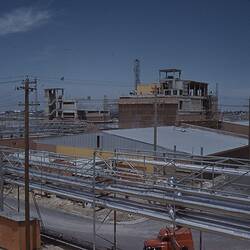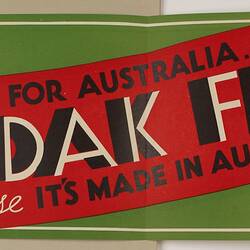Summary
Colour slide taken by Stuart Sanderson, General Manager of Manufacturing at Kodak, of the construction of the Emulsion Making Building 2 and Emulsion Coating Building 3 with the gantry system in the foreground, Kodak Australasia Pty Ltd factory complex in Coburg, January 1958.
All services to the factory buildings were reticulated from a central power house via a gantry system. The plant and layout of the Power House (Building 11) was chosen to provide a high degree of energy efficiency and standby capacity. The gantry carried the following services: chilled water at 3ºC for cooling and air conditioning; ethylene-glycol brine at -9ºC for chill rooms, low dew point drying and emulsion chilling; saturated steam at 70Kpa for emulsion heating and air conditioning; saturated steam at 700KPa for emulsion heating; condensate return to boilers; compressed air at 550KPa for machine actuation and instrument controls; electrical cables at 415V 50Hz 3phase, distilled water and clarified water for emulsion making and testing. The steam, chilled water and brine pipes were all heavily lagged and clad for efficiency and protection reasons. The steam pipes in particular had large loop sections to allow for expansion.
Construction of the Coburg complex began in 1957 on twenty three hectares of former farmland. Since 1908, Kodak had been operating from the factory in Abbotsford and had gradually outgrown the premises. The Abbotsford factory remained operational while the Coburg plant was being built until it closed in1966. Architect Harry Norris of H A & F L Norris & Associates, created the design for the new factory and individual buildings, while the building contract was awarded to Lewis Constructions Pty Ltd.
The still uncompleted Coburg factory complex was officially opened on 14 April 1961 by the Prime Minister, Robert G. Menzies with Dr. A Chapman, President of Eastman Kodak Company, in attendance. The complex was the national headquarters of Kodak Australasia Pty Ltd and its manufacture of silver halide photographic products. It replaced the Abbotsford factory where Kodak had been operating since 1908. The Abbotsford premises eventually closed in 1966.
Kodak manufactured and distributed a wide range of photographic products to Australasia, such as film, paper, chemicals, cameras and miscellaneous equipment. Its client base included amateur and professional photographers, as well as specialist medical and graphic art professionals who used photography, x-ray and other imaging techniques.
This slide is part of the Kodak collection of products, promotional materials, photographs and working life artefacts collected from Kodak Australasia in 2005, when the Melbourne manufacturing plant at Coburg closed down.
Description of Content
View of building and pipeline construction. In the foreground are small temporary structures to the left and a parked van. The site is serviced by electricity poles and wires running diagonally in the image. The pipes are elevated from the ground by a steel framework structure. Buildings are visible mid-ground of the photograph.
Physical Description
Colour 35mm slide in cardboard casing.
More Information
-
Collection Names
-
Collecting Areas
-
Acquisition Information
Donation from Kodak (Australasia) Pty Ltd, Ms. Kate Metcalf - Kodak (Australasia) Pty Ltd, 2005
-
Acknowledgement
Courtesy of Kodak (Australasia) Pty Ltd.
-
Place & Date Depicted
-
Organisation Depicted
Kodak (Australasia) Pty Ltd, Coburg, Greater Melbourne, Victoria, Australia, 1958
-
Format
Slide, 35 mm, Colour
-
Inscriptions
Front, printed: 'KODACHROME/TRANSPARENCY/PROCESSED BY KODAK' Back, handwritten: 'EMULSION & CTG/BLDINGS./DEC 58'
-
Classification
Manufacturing & industry, Photographic products, Factory exterior views
-
Category
-
Discipline
-
Type of item
-
Overall Dimensions
50 mm (Width), 50 mm (Height)
-
Keywords
Building & Construction, Factories, Gantries, Manufacturing Plants, Photography, Making History - Kodak Collection



